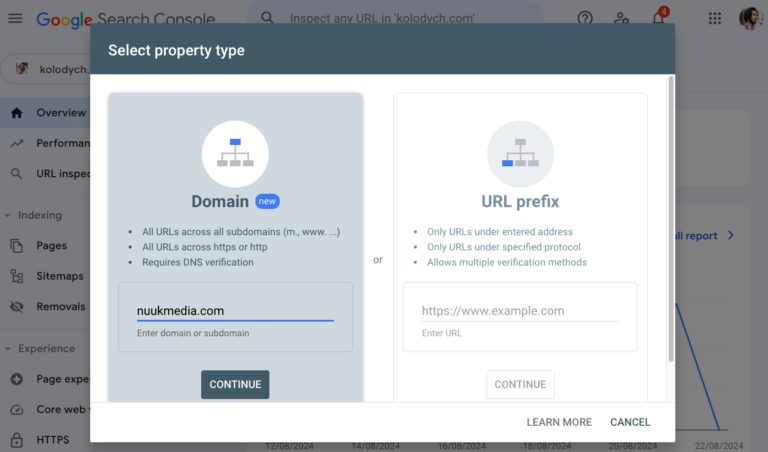If you’re new to website management or digital marketing, mastering tools like Google Search Console and Google Analytics is essential. These tools provide invaluable insights into your website’s performance, user behavior, and SEO health. This guide will primarily focus on helping you get started with Google Search Console to optimize your website’s visibility in search results, along with a brief overview of setting up a Google Analytics account.
Section 1: Setting Up Google Search Console
Step 1: Set Up Google Search Console
Google Search Console is a free tool that helps you monitor and troubleshoot your site’s presence in Google Search results. Start by signing into your Google Search Console account, press “Add Property” and type your website’s domain address as a property. This step is critical for any website owner who wants to track how their site is performing in Google search results.
Step 2: Verify Your Website
To gain full access to Google Search Console data, you must verify ownership of your website. Verification can be done via several methods, including HTML file upload, HTML tag, DNS record, or through your Google Analytics setup. Choose the method that best suits your current website setup.
Step 3: Submit Your Sitemap
A sitemap is crucial for Google to index your website effectively. By submitting your sitemap through Google Search Console, you ensure that all your website’s pages are crawled and indexed by Google Search. This step helps Google understand the structure of your site, improving its visibility in search results.
Step 4: Monitor Search Console Performance
Use the “Performance” report in Google Search Console to track your website’s search performance. This feature allows you to analyze metrics such as clicks, impressions, and average position for different queries. Understanding these metrics is essential for improving your site’s performance in Google Search.
Step 5: Google Search Console Webmaster Tools
The Webmaster Tools within Google Search Console offer a range of features designed to help you improve your site’s visibility. These tools include insights on mobile usability, Core Web Vitals, and manual actions that may affect your search rankings. Regularly monitoring these tools can help you identify and fix issues before they impact your site’s performance.
Section 2: Setting Up Google Analytics
While this guide focuses on Google Search Console, it’s also important to set up a Google Analytics account. This tool complements Google Search Console by providing deeper insights into user behavior on your website. Start by visiting the Google Analytics website and following the prompts to set up a new account for your site.
Once your Google Analytics account is created, you need to set up Google Analytics on your website. This typically involves adding a tracking code to your website’s HTML. For most users, especially those using platforms like WordPress, plugins simplify this process, making it easy to start collecting data right away.
With the introduction of Google Analytics 4 (GA4), it’s crucial to set it up alongside Universal Analytics. GA4 offers enhanced features like cross-platform tracking and event-based data collection, making it a valuable addition to your analytics toolkit.
Conclusion
Mastering Google Search Console is essential for anyone looking to improve their website’s presence in Google Search. From setting up and verifying your site to submitting a sitemap and monitoring performance, Google Search Console provides the tools you need to ensure your website is optimized for search engines. While Google Analytics offers additional insights into user behavior, Google Search Console is the foundation for a successful SEO strategy. Regularly using and understanding these tools will help you make data-driven decisions to improve your website’s visibility and performance in Google Search results.
Post By – Kolodych (https://kolodych.com/)


